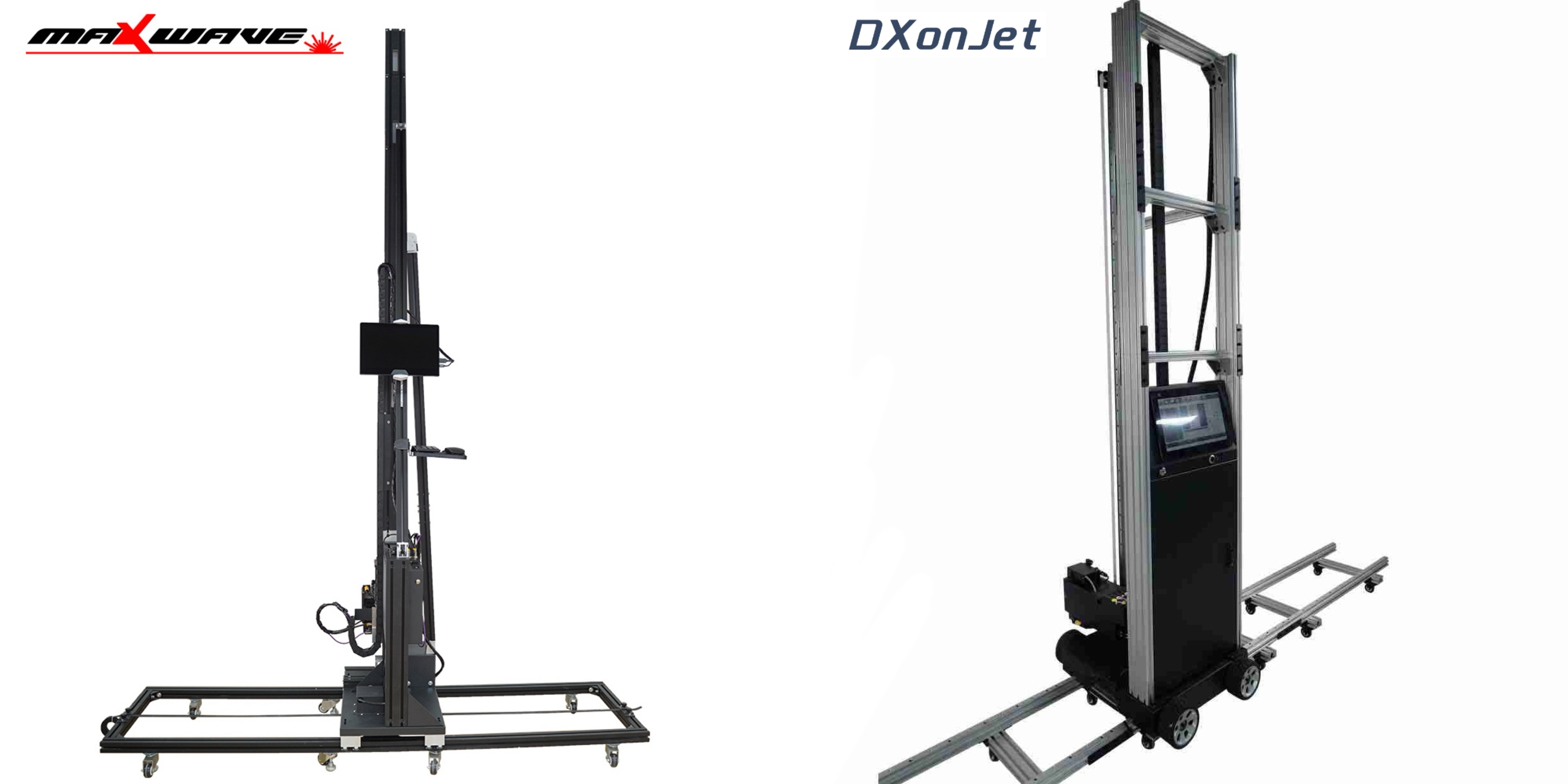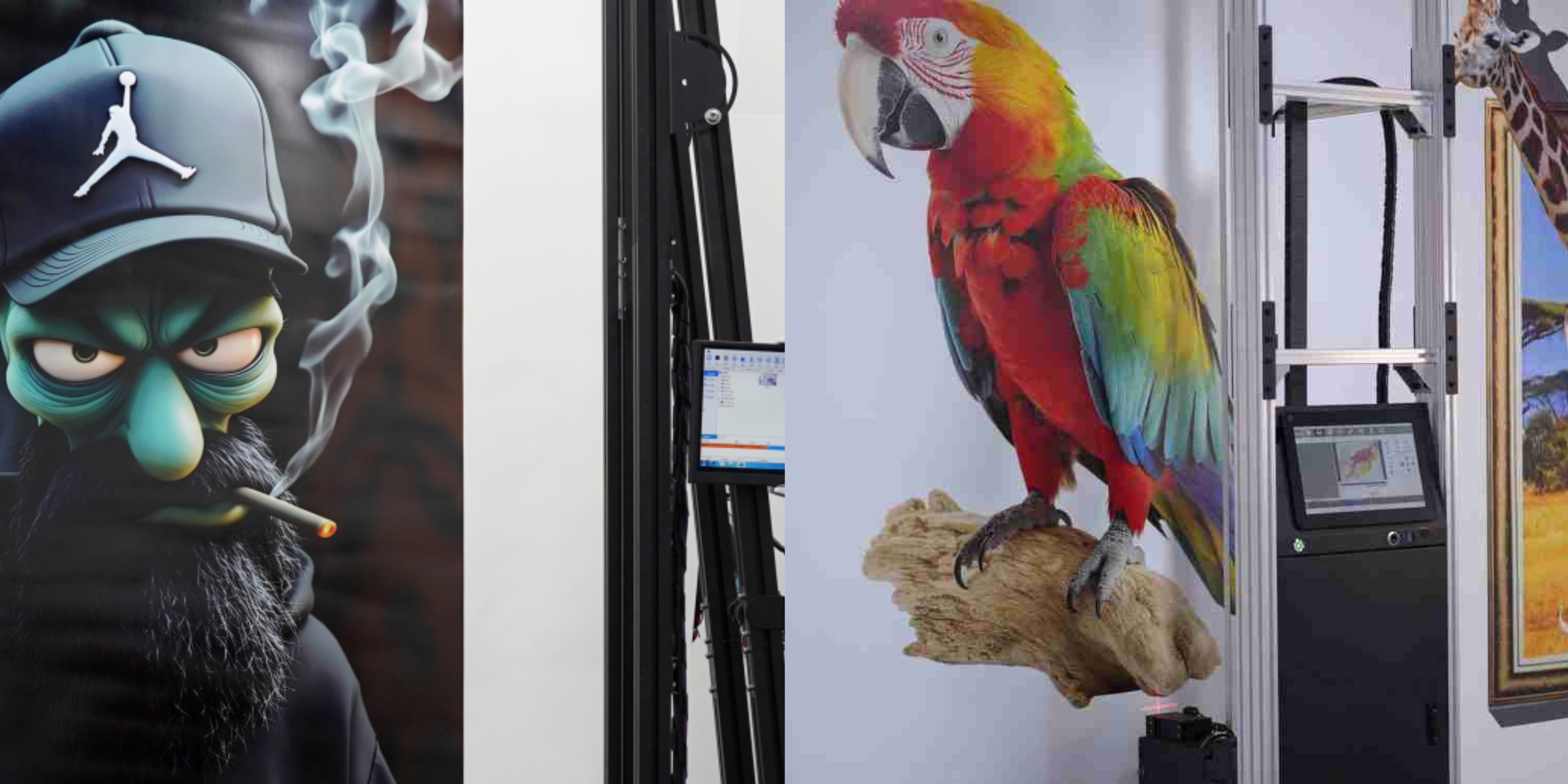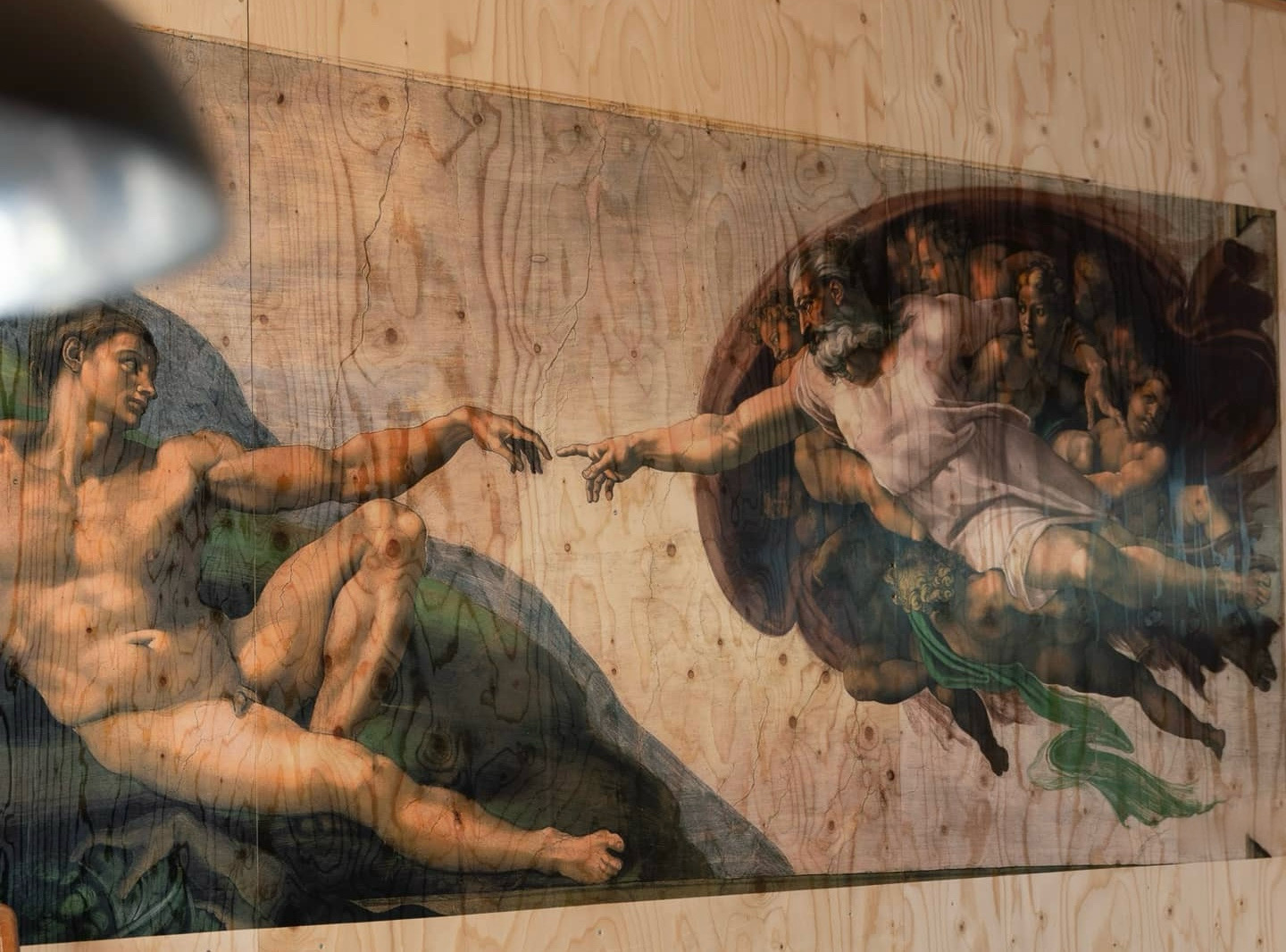Creating vibrant, professional-quality wall art starts with choosing the right wall printer. Maxwave and Dxonjet are two of the leading brands in the industry, each offering unique features, color capabilities, and printing technologies. Whether you’re an entrepreneur starting a mural business or a designer aiming for gallery-level precision, understanding the key differences between these machines will help you make the right investment for your creative projects.
| Specification | Maxwave | Dxonjet |
|---|---|---|
| Max Print Height | 2.5–4 m (upgradable to 4.5 m) | 2.5–4 m |
| Max Print Width | Unlimited width with modular rails/design | |
| Resolution | Up to 2880 dpi | Up to 1440 dpi |
| Ink Type | Solvent-free UV, 7-color option (CMYK+W+LC+LM) | UV, CMYK+W, optional 8-color |
| Printheads | Dual Epson or Ricoh, optional 7-color Ricoh | Dual or four Epson/TX800, durable for heavy use |
| Special Features | Auto ink tracking, UV-LED curing, dedicated white ink | Fast printing, multi-layer/3D effects, instant curing |
| Maintenance | Electric pump, auto-clean, ink alerts | Auto-clean, easy upkeep, works on many wall types |
| Applications | High-precision murals, gallery art, rich color projects | Large commercial murals, fast multi-layer prints, industrial use |
Wall Printer Print Resolution
From my experience with Maxwave and DXonjet wall printers, both brands produce high-quality prints. They do have distinct differences in resolution that could influence your choice.
- Maxwave printers give you selectable resolutions of 360, 720, 1440, and 2880 dpi (dots per inch). The top models support up to 2880 dpi, which is the highest resolution I have seen available for wall printers. I recommend this ultra-high resolution for projects that need very detailed, sharp images. This includes fine art reproductions or intricate wall murals. While many production settings are at 2400 dpi, I suggest you push the Maxwave to its full 2880 dpi capability for gallery-level detail.
- DXonjet provides professional results with resolutions up to 2400 dpi. Its VPJET 4.0 models use advanced printhead technology like the Epson i3200. This creates prints that users describe as “crisper.” The fine print dots are tiny (about half a millimeter) and you can see them only with a close look. Based on my field tests, clients usually can’t tell the difference in detail between DXonjet and Maxwave prints in a real-world setting.
Key Technical Factors and My User Experience
Printhead Technology: Maxwave uses dual Japanese Ricoh or Epson printheads. I find this guarantees sharp edges at all resolution settings. DXonjet also uses advanced heads, which contributes to its sharp image quality.
3D and Texture Effects: I like that both brands offer 3D and multi-layer (3D/5D) printing. This creates a touchable, textured effect that adds to their artistic and commercial use.
Practical Applications
-
I suggest Maxwave for mural work that needs portrait-level detail or fine art quality. You can customize the resolution to fit your project. For example, use 720/1440 dpi for a quick poster or 2880 dpi for museum-quality work.
-
I find DXonjet is great for commercial wall branding and retail displays. The 2400 dpi resolution gives you bold, crisp graphics at a speed that works for commercial jobs.
In my opinion, Maxwave leads on technical specs with its ability to print at 2880 dpi. On the other hand, DXonjet’s crisp, 2400 dpi output meets most practical wall printing needs. In the eyes of clients, both produce “photo-quality” results. The prints look almost identical unless you look at them under a magnifying glass. I’d say either is a strong choice. Your decision should depend on your specific resolution and workflow needs.
Print Speed: Comparing Maxwave and DXonjet Wall Printers
From my experience, print speed is a very important factor when picking a wall printer. It affects how quickly you can finish a job and how profitable your business is. I’ll break down how Maxwave and Dxonjet perform for different printing tasks.
Maxwave Print Speed
– Draft Mode: Reaches up to 10 m²/h. Some UV models can handle 10–15 m²/h depending on the machine’s setup.
– Standard Mode: Gives you a solid 8 m²/h, which I find is ideal for most general mural or branding jobs.
– High-Resolution Mode: Prints at 5 m²/h. I recommend this mode when you set it to the maximum 2880 dpi for gallery-level detail.
– Portable/Lightweight Models: These models print between 8 and 15 m²/h. I like that they offer both speed and flexibility for projects on-site or in multiple locations.
Dxonjet Print Speed Benchmark
I could not find exact figures for Dxonjet’s print speed from public information. Based on my industry knowledge, I’d say most good wall printer brands, including Dxonjet, aim for a standard of 8–15 m²/h in draft and standard modes. This keeps them competitive.
Maximum Print Size (Height & Width): Comparing Maxwave and Dxonjet Wall Printers
If you’re buying a wall printer machine, you need to think about the maximum print size for both height and width. This is a big deal for large murals or inside commercial buildings. I will compare the print size flexibility of Maxwave and Dxonjet. My comparison is based on their official specs and what I have seen them do in real projects.
Maxwave Wall Printers: Height & Width Capabilities
- Maximum Print Height: Standard Maxwave models print up to 2.5 meters high. You can get upgraded versions that print 3.5 meters or even 4 meters (13 ft) high. I’ve found that some models can even be customized up to 4.5 meters on the Z-axis, which is great for very tall murals or building projects.
- Maximum Print Width: They offer unlimited width. Maxwave printers have modular rails you can extend. This lets you print across a very long wall with no seams.
- Model Examples: From what I’ve worked with, their UV models have standard print areas of 2500 mm × 6000 mm (2.5 × 6 m) or 3000 mm × 6000 mm. You can add more rails to print wider.
- Portable Models: The portable units from Maxwave are quite flexible. You can extend their height with different rail sizes (1 m, 0.5 m, 0.3 m, and 0.2 m). I’ve found you can set them up to print as high as 3.5–4 meters.
My personal experience:
I have watched a Maxwave system print a single mural that was 3.5 meters tall on a 10-meter-wide wall. It really showed me their “unlimited width” claim is true. I think their modular height system is also a big advantage for outdoor projects or work on different sites.
Dxonjet Wall Printers: Size Specifications and Flexibility
- Maximum Print Height: Standard Dxonjet models can print from 2.5 meters to 3.2 meters high in one go. Some of their advanced machines can reach up to 4 meters with extension kits. In my opinion, you don’t see these as often as Maxwave’s taller standard models.
- Maximum Print Width: Dxonjet also gives you “unlimited width.” They use modular rails that let you print giant murals that cover an entire wall.
- System Notes: To print taller with a Dxonjet, you will most likely need to buy an optional kit. Their standard setups don’t reach the same heights as Maxwave’s top options.
Here’s what I’ve seen in real life:
A Dxonjet printer can make a mural about 3 meters high and keep printing wider to cover the whole wall. If your project needs very tall graphics, I recommend you check if an extension kit is available before you buy.
My Final Thoughts: Size Flexibility for Wall Printing
I believe Maxwave is better for maximum height. They offer more tall options from the start and have a more flexible system for custom work. Both brands give you unlimited width. You can make large, seamless murals with either. If you need to print extra-tall images or change height at the job site, I think Maxwave’s modular system has an advantage. Dxonjet is a good choice for most commercial murals, but you might need to buy add-ons for very tall projects.
Wall Printer Ink System and Technology
The ink system is key for print quality and your long-term costs. Based on my experience, this is a crucial factor. Let’s look at how Maxwave and Dxonjet wall printer compare.
My View on the Maxwave UV Ink System
Maxwave uses solvent-free UV ink, which is eco-friendly and low-odor, with coverage of 60–100 m² per liter for cost-effective large murals. It supports CMYK, CMYK+White, and optional seven-color (CMYK+W+LC+LM) setups for richer, more accurate colors. Dual Epson or Ricoh printheads can achieve 2880 dpi, with an optional fifth head for white ink, ideal for dark or colored walls. UV-LED curing ensures prints are durable, scratch-resistant, and ready for outdoor use, while automatic management features like electric pumping, auto-cleaning, and ink tracking reduce maintenance and maintain consistent quality.
My Thoughts on the Dxonjet UV Ink System
Dxonjet uses refillable UV ink bottles, which are easy to handle and cost-effective. Its CMYK+White setup emphasizes high-output white ink for vibrant prints on any wall color. Equipped with the Epson I3200 printhead, it delivers precise, consistent colors and fast operation—completing standard wall prints in around 22 minutes. The printer supports 3D and multi-layer effects, with instantly cured UV ink ready for tough conditions. Automatic cleaning and easy maintenance make it user-friendly across a variety of wall surfaces.
Key Differences and My Insights
Both printers use UV curing for instantly dry, durable outdoor prints. Maxwave offers automatic ink tracking and a seven-color setup for gallery-quality murals, plus an extra printhead for layered effects. Dxonjet provides a refillable ink system for cost savings, strong white ink output, and 3D capabilities. For flexibility, Dxonjet works on all wall materials, while Maxwave’s modular colors allow more customization.
Printhead Type and Capacity: A Look at Maxwave and Dxonjet Wall Printer
From my experience, the printhead is a key part of any wall printer. It impacts both the final print quality and how efficiently you can work. Here is how I see Maxwave and Dxonjet in this area:
Maxwave Printhead Setup and Capacity
Maxwave uses Epson printheads, often in a dual-head setup, providing excellent color accuracy and coverage for CMYK and CMYK+White prints. For high-end work, upgraded models offer dual Ricoh seven-color heads for an expanded color range suitable for commercial or gallery-level murals. Technical specs include up to 2880 dpi resolution, 3.0PL droplet size for fine details, print speeds of 5–10 m²/h, ink coverage of 60–100 m² per liter, maximum height up to 4 meters, unlimited width with modular rails, and solvent-free or UV-curable inks with UV-LED instant curing for durable, long-lasting prints.
Dxonjet Printhead Technology and Flexibility
Dxonjet uses advanced UV printheads from brands like Ricoh and Epson TX800, with double or four-head setups to match different workloads. The four-head configuration supports high-speed, multi-layer printing across surfaces like glass, metal, concrete, and wood. Technical specs include up to 1440 dpi resolution, long-lasting printheads rated for over 100 billion ink ejections, standard CMYK+White channels (with some models supporting up to 8 colors), print heights from 2.5 to 4 meters with unlimited width via modular design, and instant UV ink curing compatible with both porous and non-porous surfaces.
Summary Table:
| Factor | Maxwave | Dxonjet |
|---|---|---|
| Printhead Type | Double Epson, optional Ricoh 7C | Double/Quadruple Ricoh, Epson TX800 |
| Max Resolution | 2880 dpi | 1440 dpi |
| Head Capacity | Double Head (standard) | Double or Quadruple Head |
| Ink Efficiency | 60–100 m²/liter | Not specified; built for heavy-duty |
| Color System | CMYK/CMYK+White/7C | CMYK+White (up to 8 channels) |
| Durability | UV-LED curing, solvent-free | UV-LED, high ink ejection lifespan |
UV Curing Technology in Wall Printers: Maxwave vs Dxonjet
I think UV curing is a huge step forward for wall printer machines. The ink cures right away, the prints are very durable, and it works on lots of different surfaces. Here’s my look at how Maxwave and Dxonjet use this tech.
Maxwave: Dual LED UV Curing for Pro-Grade Results
Maxwave uses a dual LED UV system for instantly cured, fade-resistant prints indoors and outdoors. Its solvent-free UV inks are safe and eco-friendly. Automatic maintenance with electric ink pumping and nozzle cleaning prevents clogs and ensures consistent quality. It prints at 360–2880 DPI with dual Ricoh heads, and the seven-color plus white ink option allows for creative, detailed designs.
Dxonjet: All-Material Adaptability & Outdoor Strength
Dxonjet printers, like the VPJET 4.0, use direct UV curing, producing waterproof, sun-proof prints ready for harsh conditions. The precise curing enables 3D and layered effects, ideal for large commercial projects in malls, hotels, or schools. Equipped with a durable single printhead, these printers handle heavy use year-round. I’ve seen outdoor murals maintain vibrant colors and quality for over 18 months, even in challenging weather.
Key Benefits & Summary
Both Maxwave and Dxonjet use instant UV curing, preventing smudges and drying delays while producing bright, durable prints that withstand solvents, sunlight, and cleaning. This technology also allows multi-layer, textured, or even Braille printing, offering creative and profitable possibilities. For high-traffic or outdoor areas, UV curing ensures long-lasting, reliable results, making both printers dependable choices.
Summary
Both Maxwave and Dxonjet offer powerful solutions for wall printing, but your choice ultimately depends on your priorities—Maxwave shines in color versatility and high-resolution detail, while Dxonjet excels in industrial flexibility and fast, multi-layer printing. By weighing these differences against your project needs and budget, you can pick the printer that will maximize your efficiency, creativity, and profits. Ready to elevate your wall printing business? Start exploring your options today and request a quote from the experts for your wall printer!



